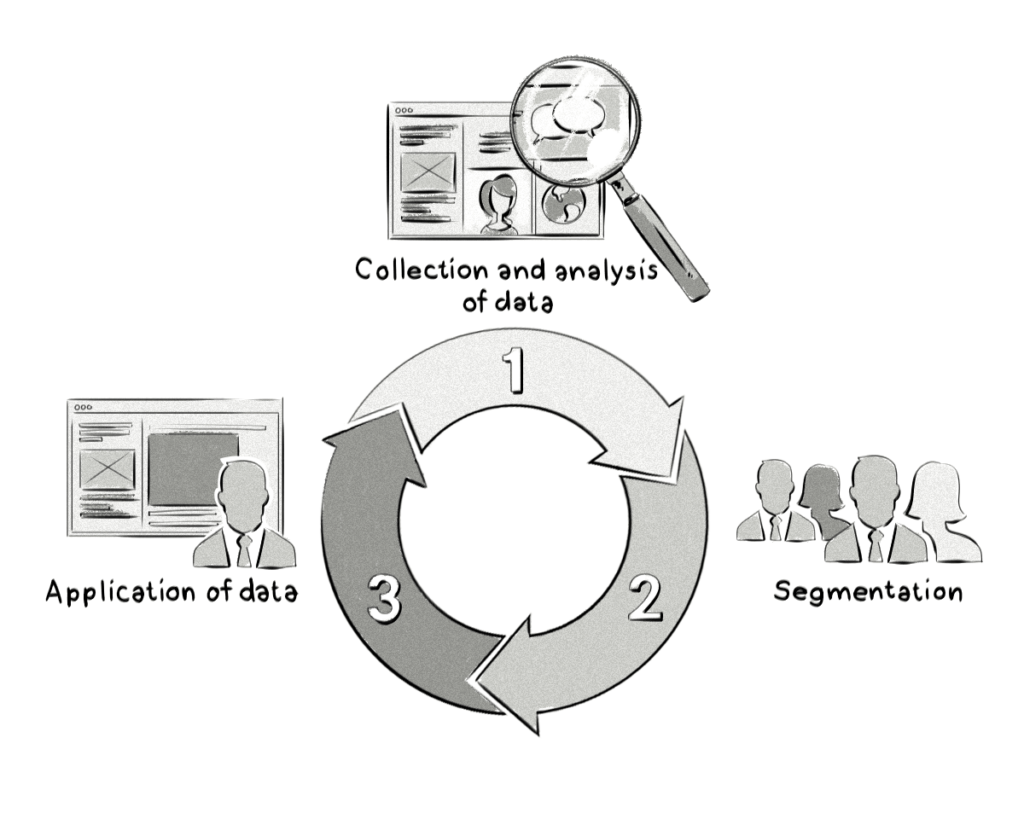For years, in order to increase the relevance and effectiveness of ads and marketing messages displayed to online audiences, publishers and advertisers have taken advantage of behavioral data for both advertising and personalization.
In this post, we will take a closer look at what behavioral targeting is and how it works, and will discuss the consequences the General Data Protection Regulation will have on this ad-targeting technique.
What is Behavioral Targeting?
Behavioral targeting (also known as online behavioral advertising) is a method that allows advertisers and publishers to display relevant ads and marketing messages to users based on their web-browsing behavior. Broadly speaking, this form of targeting typically relies on data connected to a user’s behavior, such as:
- Pages viewed
- Previous search terms
- Amount of time spent on a website
- Ads, content, and buttons clicked
- Last date of website visit
- Other information about their interactions with the website
What’s the difference between behavioral targeting and online behavioral advertising (OBA)?
In simple terms, online behavioral advertising (OBA) is a form of online advertising that uses behavioral targeting to display certain ads and personalized content (e.g. product recommendations) to uses. So in a sense, OBA is the type of advertising and behavioral targeting is the technique.
Types of Behavioral Targeting
There are two main types of behavioral targeting: onsite and network.
Onsite Behavioral Targeting
Onsite behavioral targeting happens within a particular site and is typically implemented as part of website personalization. Ads are displayed to the user based on behavioral data and/or other information about the visitor gathered on the pages of the same site. This method plays a significant role in building a more streamlined and relevant experience for the users.
For further reading, see our blog post about personalization.
Onsite behavioral targeting allows advertisers and publishers to display relevant content, recommended products, and promotions to users who are visiting the site. This way, users are more willing to engage with the site, spend more time browsing, and convert (i.e. perform a desired action like making a purchase or signing up for a newsletter).
AdTech & Programmatic Platform Development
We can help you design and build real-time bidding, and programmatic advertising platforms for all advertising channels — display and native, in-app mobile, video and audio, OTT and CTV, in-game and DOOH.
Network Behavioral Targeting
In behavioral advertising, implied choices are made for the audience. The audience is then categorized based on factors like purchase intent, interests, etc., that come from demonstrated web behavior. Usually, the data is collected only on the advertiser’s site and is used for retargeting and personalization.
In network behavioral targeting, such data can be collected and shared across multiple sites on the Internet. This doesn’t include data like people’s names, email addresses, or telephone numbers, but may involve device-identifying information such as IP and MAC addresses, cookies, or other device-specific IDs. The algorithms crunch the data and assign the user to specific segments. The algorithm can then assume a person’s age, gender, and possible purchase decisions so they can display customized ads the person would be more likely to click.
An example would be a user seen on a number of automotive sites, business sites, and male-fashion sites. A reasonable guess would be that the user is male. The advertiser can buy this segment—typically provided by data-management platforms (DMPs) that are integrated with and sell to demand-side platforms (DSPs)—to target the relevant audience.
How Does Behavioral Targeting Work?
As mentioned above, behavioral targeting consists of collecting information about a visitor and delivering relevant ads that match this specific person’s profile. Gathering behavioral data—a prerequisite for effective behaviorally targeted ads—can be performed in multiple ways, but usually a DMP is needed to aggregate the behavioral data about the site’s visitors. DMPs are responsible for collecting, storing, and organizing data for advertisers.
The data used for behavioral targeting can come from a range of sources, including websites, mobile apps, CRM systems, and other marketing-automation systems, and can include:
- User login information (for registered users)
- IP address and geolocation
- Pages (or products) viewed on the site
- Duration of visit
- Clicks
- Recency of visit
- Interaction with elements of the site
- Previous purchases
- Demographics
- Content read
- Sections of the page regularly visited by a user
- Searches within the site
- Websites they’ve visited
Almost all advertisers and publishers are able to gather some onsite data on their customers and visitors. Knowing how to leverage the information towards achieving specific marketing goals is critical for effective behavioral targeting. Taking advantage of the method is an easy way to boost conversion rates.
The Behavioral Targeting Process

1. Collection and Analysis of Data
User data is collected from a range of sources, but is typically done via tracking pixels (also known as third-party cookies) and stored in a DMP or other AdTech platform like a DSP. The more data, the more accurate the targeting. The collected data is then analyzed and used to create user segments.
2. Segmentation
Users are clustered into segments by behavior (for example, people who travel a lot, people who like bikes, people who often return to the same product category, etc).
3. Application of Data
Ad campaigns are implemented to match a specific user segment, making the advertising more relevant for specific groups of users and increasing the likelihood of conversions and responses.
Apart from using data collected by DMPs and other AdTech platforms, behavioral targeting can be enriched with data pulled from registered users’ profiles.
Registered users make a purchase in an online store. Those sales, along with the user’s site-navigation history, are often stored and analyzed to make targeted offers the next time the user comes online.
Unregistered users can be targeted using cookie information saved on the customer’s browser. When the user visits the site again, the cookie (unless it was deleted by the user) is sent to the web server, making it possible to target the user.
There is also a way to collect and track data through Internet service providers (ISPs) who perform methods like deep packet inspection to analyze their customer’s traffic and determine the types of websites they visit.
Then, the data is sold to marketing and ad-serving companies to deliver more personalized ads. This is a common practice, as many ad-serving companies buy the behavioral data from third parties like Nielsen (formerly eXelate) and dataLogix (now part of Oracle).
What’s the Difference Between Behavioral Targeting and Contextual Targeting?
Contextual targeting involves displaying ads that are relevant to the content of the page. Typically, this method of targeting doesn’t use information about users; it only takes advantage of the context of the ad. However, behavioral data can be used to improve the relevance of contextual ads.
Behavioral targeting allows advertisers and marketers to target individual users. The method is based on the premise that the ad should be relevant not to the page, but to the user who is visiting the page. Behavioral targeting has been widely used in online advertising and marketing for over a decade due to the growing availability of user data.
To be effective, behavioral targeting must have sufficient information about the user.
Benefits of Behavioral Targeting
The amount of data marketers have about users allows them to create very detailed profiles and to display ads relevant to each user segment accordingly. The premise behind behavioral targeting is that it benefits the visitor as much as it benefits the site displaying the ads.
Website experience, in turn, becomes more relevant and interesting to the user (read more on content personalization here), and users are generally more engaged in well-targeted ads and content. Implementing behavioral targeting offers a large return on investment in the form of high click-through rates (CTRs) and better conversion rates.
Today, behavioral marketing is not just about explicit user information, but also about making sense of data and drawing proper conclusions.
Challenges of Behavioral Targeting and the Impact of the GDPR
With the General Data Protection Regulation (GDPR) in effect, this targeting method may be challenged by stricter rules concerning storing cookies in a user’s browser. The GDPR may force marketers to relinquish much of their dependence on behavioral data and seek new targeting methods.
What should take the place of behavioral data collection in a post-GDPR world? How will digital marketers display the right messages to the right eyeballs at the right times? For many, the answer lies in contextual advertising.
We’ve written about contextual targeting in another article on the Clearcode blog.
The power of true contextual targeting is compliance with the GDPR due to its minimized reliance on personal data.
Contextual targeting allows companies to almost completely avoid the GDPR, provided they don’t collect or use any personal data. Many companies are already taking advantage of contextual targeting methods.
AccuWeather, for example, recently partnered with Comprendi, a company offering contextual advertising automation. The goal of the collaboration is to provide real-time ad-personalization algorithms. By tapping into information about allergies, migraines, driving, and lawn and garden forecasts, advertisers partnering with AccuWeather can display ads to specific audiences and locations influencing possible purchase decisions and interests (e.g. gardening, sunbathing, raincoats, trekking, etc).
Another example is Quora, which currently offers advertisers new options for GDPR-safe contextual targeting. The targeting is based either on questions (ads can be shown based on answers to specific questions) or specific topics.
Methods like these will certainly proliferate and become more advanced in the coming months. Also, we must not forget that the GDPR is in force in Europe and applies to EU residents and citizens, but behavioral targeting is still allowed in other parts of the world and used by major players in the online marketing industry, including Facebook and Google.
AdTech & Programmatic Platform Development
We can help you design and build real-time bidding, and programmatic advertising platforms for all advertising channels — display and native, in-app mobile, video and audio, OTT and CTV, in-game and DOOH.








